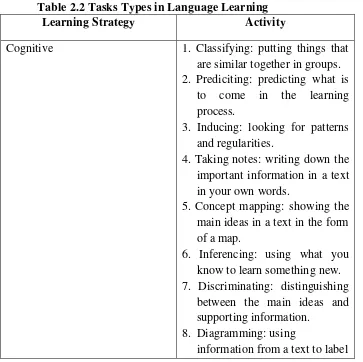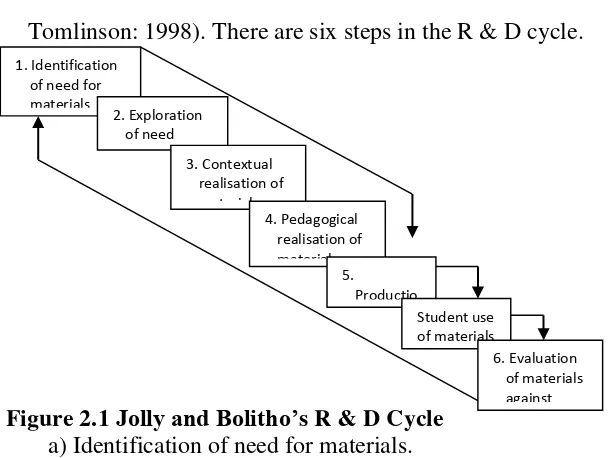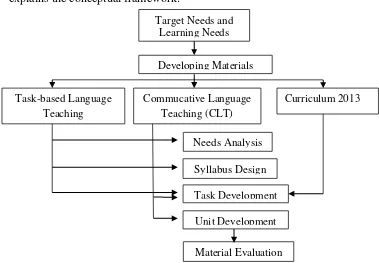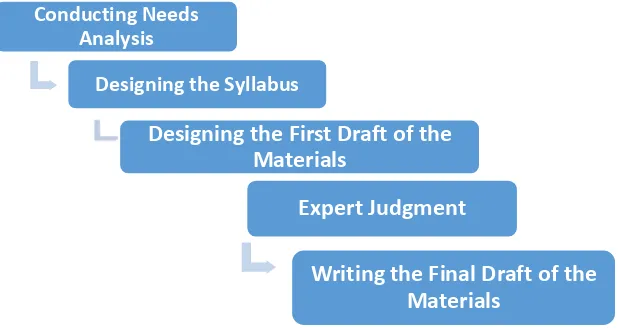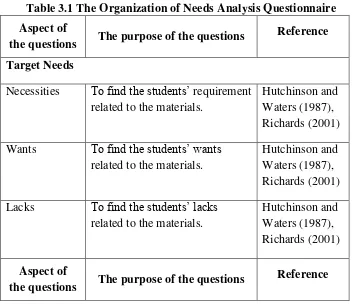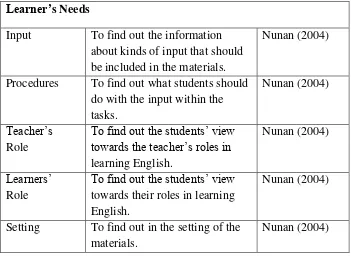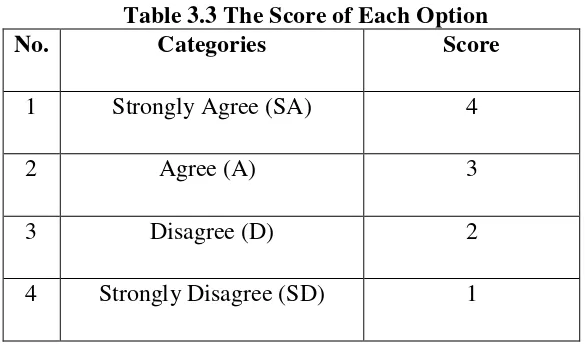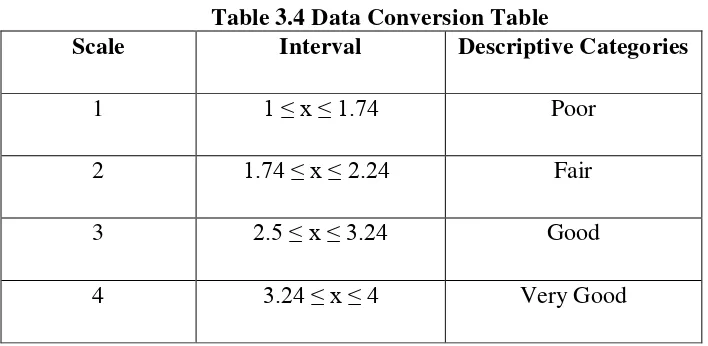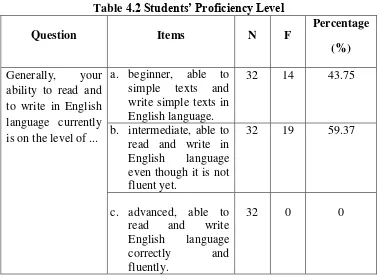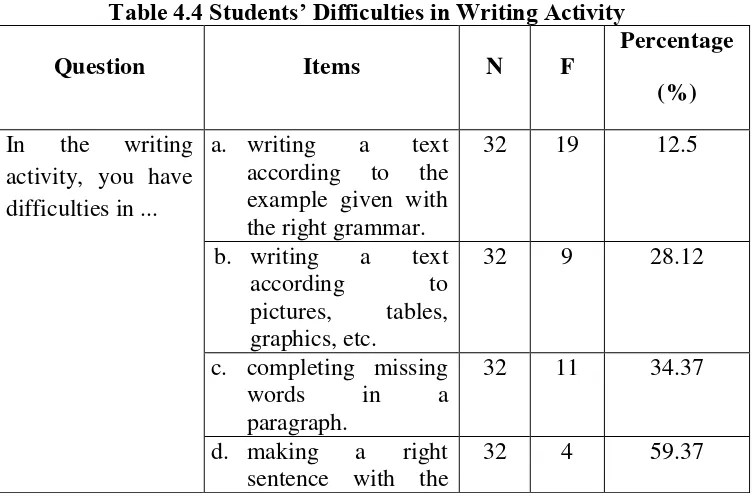A THESIS
Presented as a Partial Fulfilment of the Requirements for the Attainment of the Sarjana Pendidikan Degree in English Language Education
TITLE
By:
Rizqie Oktanti Triandari 10202241054
ENGLISH LANGUAGE EDUCATION DEPARTMENT FACULTY OF LANGUAGES AND ARTS
ii
APPROVAL SHEET
iv
v MOTTO
Don’t compare your life to others. You have no idea what
vi
DEDICATION
vii
viii
TABLE OF CONTENTS
Page
TITLE ... i
APPROVAL SHEET ... ii
RATIFICATION SHEET ... ii
PERNYATAAN ...iv
MOTTO ... v
DEDICATION ...vi
ACKNOWLEDGEMENTS ... vii
TABLE OF CONTENTS ... viii
LIST OF APPENDICES ... x
LIST OF TABLE ... xi
LIST OF FIGURES ... xiii
ABSTRACT ... xiv
CHAPTER I INTRODUCTION ... 1
A. Background of the Study ... 1
B. Identification of the Problems ... 4
C. Limitation of the Problems ... 6
D. Formulation of the Problems ... 6
E. Objectives of the Study ... 6
F. Significance of the Study ... 7
CHAPTER II LITERATURE REVIEW AND CONCEPTUAL FRAMEWORK ... 8
A. Literature Review ... 8
1. Curriculum 2013 ... 8
2. The Reading Skills ... 11
3. The Writing Skills ... 14
4. Task-Based Language Teaching (TBLT) ... 17
5. Materials ... 23
ix
B. Conceptual Framework ... 33
CHAPTER III RESEARCH METHOD ... 35
A. Type of the Research ... 35
B. Setting and Subject of the Research ... 35
C. The Research Procedure ... 36
D. Data Collection Techniques and Instruments ... 39
E. The Data Analysis Techniques of the Research ... 41
CHAPTER IV RESEARCH FINDINGS AND DISCUSSION ... 44
A. Research Findings ... 44
1. The Results of Needs Analysis ... 44
2. The Syllabus ... 60
3. The Materials ... 61
4. The Expert Judgment ... 63
5. Final Draft ... 84
B. Discussion... 84
CHAPTER V CONCLUSIONS AND SUGGESTIONS ... 90
A. Conclusions ... 90
1. Target Needs ... 90
2. Learning Needs ... 91
3. Characteristics of Reading and Writing Materials for Grade Eight Students of SMP Negeri 4 Magelang. ... 92
B. Suggestions ... 94
x
LIST OF APPENDICES
Appendix A. The Core and Basic Competence of Grade VIII of Junior High School
Appendix B. The Needs Analysis Questionnaire Appendix C. The Needs Analysis Data
Appendix D. The Syllabus Design Appendix E. The Description of Tasks Appendix F. The First Draft of the Materials Appendix G. The Expert Judgment Questionnaire Appendix H. The Expert Judgment Data
xi
LIST OF TABLE
Table 2.1 Steps of English Instructional Process based on Scientific Approach
Table 2.2 Tasks Types in Language Learning
Table 3.1 The Organization of Needs Analysis Questionnaire Table 3.2 The Organization of the Expert Judgment Questionnaire Table 3.3 The Score of Each Option
Table 3.4 Data Conversion Table
Table 4.1 The Goal of Learning English Table 4.2 Students’ Proficiency Level
Table 4.3 Students’ Difficulties in Reading Activity Table 4.4 Students’ Difficulties in Writing Activity Table 4.5 Students’ General Wants in Learning English Table 4.6 The Length of Reading Input
Table 4.7 The Importance of Pictures in Materials Table 4.8 The Topic of the Materials
Table 4.9 Reading and Writing activity
Table 4.10 The Amount of Tasks in the Materials Table 4.11 Grammar Activity
Table 4.12 Vocabulary Activity
Table 4.13 Students’ Preference in Studying
Table 4.14 Students’ Preference in Doing the Tasks Table 4.15 Students’ View about Teacher’s Role Table 4.16 Students’ View about Learners’ Role
Table 4.17 The Appropriateness of the Content of Unit 1 Table 4.18 The Appropriateness of the Language of Unit 1 Table 4.19 The Appropriateness of the Presentation of Unit 1 Table 4.20 The Appropriateness of the Graphic of Unit 1 Table 4.21 The Revision of Unit 1
xii
Table 4.23 The Appropriateness of the Language of Unit 2 Table 4.24 The Appropriateness of the Presentation of Unit 2 Table 4.25 The Appropriateness of the Graphic of Unit 2 Table 4.26 The Revision of Unit 2
xiii
LIST OF FIGURES
Figure 2.1 The Components of Tasks Figure 2.2 Jolly and Bolitho’s R & D Cycle Figure 2.3 Modified Material Design Process
Figure 2.4 The Conceptual Framework of the Research
Figure 3.1 The Model of Learning Materials Development which is the combination from research procedures proposed by Borg and Gall (1983) and model of materials writing proposed by Jolly and Bolitho in Tomlinson (1998)
xiv
DEVELOPING READING AND WRITING LEARNING MATERIALS FOR GRADE EIGHT STUDENTS OF SMP NEGERI 4 MAGELANG
By:
Rizqie Oktanti Triandari 10202241054
ABSTRACT
The objectives of this research are: (1) to find out the target needs of grade eight students of SMP Negeri 4 Magelang, (2) to find out the learning needs of grade eight students of SMP Negeri 4 Magelang, and (3) to develop appropriate reading and writing learning materials for grade eight students of SMP Negeri 4 Magelang.
This research belongs to Research and Development (R&D) research study. The subjects of this research were grade eight students of SMP Negeri 4 Magelang. This research adapted the R&D model proposed by Borg and Gall (1983) and Jolly and Bolitho in Tomlinson (1998) with some modifications. The steps in the modified research procedures were conducting need analysis, designing the syllabus, developing the first draft of the materials, expert judgement, and writing the final draft the materials. There were two types of questionnaire used in this research. The first was needs analysis questionnaire. It was made for obtaining the data for the needs analysis. The second was expert judgement questionnaire. It was made for obtaining the data for the appropriateness of the developed materials. The data obtained from the needs analysis and the expert judgement were analyzed quantitatively through descriptive statistics. The data from the needs analysis were used to design the syllabus and to develop the materials, while the data from the expert judgement questionnaire were used to revise the developed materials.
1
CHAPTER I INTRODUCTION
This chapter presents the main issues of the background of the study, identification of the problems, limitation of the problems, formulation of the problem, objective of the study, and sicnificance of the study.
A. Background of the Study
English is widely used in many situations, for example business, entertainment, community, social media, and education. The use of English language as an international language becomes the reason why people learn English language. The importance of learning English becomes one of the significant reason why English language is included as a lesson in the curriculum in Indonesia.
2
Creating, the materials that will be given to students must be well-prepared and be well-observed. Teachers should teach intelligently to support the goal of teaching learning process.
Besides the curriculum that is the important orientation in the education system, textbooks and other resources are also important to reach the goal of national education. Without any textbooks, students cannot learn English comprehensively. Textbooks are kinds of facilities for learning besides media and some audio lingual and visual in the classroom. In line with the importance of textbooks, learning process which is facilitated with textbooks is designed to improve students’ language ability
because students can do the exercises during the learning process. According to Nunan (1999: 81), learners usually have to rely only on the textbooks as an aid to language learning.
Based on the preliminary observation held in SMP Negeri 4 Magelang, it was found that the English textbooks used in classroom were not used intensively. Students learnt English based on the teacher’s instruction about the materials that would be learnt in certain time of each semester. The teacher often made his / her instructions to the students in order to do activities in the classroom so that the existance of the textbooks were not useful. That condition made the students only learnt English by the teacher’s instructions.
extracted from discourse. Students will get maximum benefit in both extensive and intensive reading. They are taught to read the second language with direct apprehension of meaning, without a conscious effort to translate what they are reading. Reading is the most important activity in any language class, not only as a source of information and a pleasurable activity, but also as a means of consolidating and extending one’s knowledge of the language (River, 1981: 259). Through reading
skill, students can increase their understanding and knowledge of the language.
Meanwhile, writing skills are one of the productive skills where students actually have to produce the second language themselves. Writing is considered as a difficult skill to be mastered. Students need to consider some basic skills in writing such as handwriting or typing, spelling, constructing grammatical sentences, and punctuating. Good writing skills usually develop from extensive reading, some specific training, and a good deal of practice (Davies and Pearse, 2000: 96). To progress in writing skill, students need some practice. They need to read plenty of examples of descriptive, narrative, and also recount writing to develop their skills. Because reading and writing are so important when they are collaborated in increasing students’ skills, the reading and writing materials are needed to be developed.
4
reading and writing exercises, basic grammar can be mastered by junior high school students especially at the grade eight students as stated in the Core Competence and Basic Competence. It can be noticed that the more thoroughly a learner masters the grammatical system of the language, the more effectively they can use the language for communication.
B. Identification of the Problems
The textbook used in Grade Eight of SMP Negeri 4 Magelang is a textbook entitled “When English Rings a Bell” from Kementerian
Pendidikan dan Kebudayaan Republik Indonesia 2014. The contents of the textbook are based on Curriculum 2013 with the scientific approach based on the Peraturan Pemerintah Nomor 17 Tahun 2010 tentang Pengelolaan dan Penyelenggaraan Pendidikan. It is stated that the implementation of learning process is focused on the exploration, elaboration, and confirmation completed with the process of Observing, Questioning, Collecting Data, Analyzing Data, Communicating, and Creating.
learning texts such as descriptive texts, recount texts, and narrative texts. There are some tasks about short functional texts like short message and notice. In the end of every chapters there is a production made by the students. Like a reflection, the teacher needs to make sure that the materials given are well understood by the students.
Based on Basic Competence in Curriculum 2013 for grade eight students of junior high school, language functions which are needed to be taught in the first semester are expressions of asking and giving attention, asking and giving opinion, greetings, giving and responding to instructions, giving and responding to invitations, giving and responding to prohibitions, and making personal invitations and greeting cards. While in the second semester, there are making oral and written texts about expression of giving instructions, giving and asking for facts, describing people, animals and things. Making some texts such as descriptive texts, recount texts, and narrative texts is also needed to be taught.
6
C. Limitation of the Problems
Due to the limitation time to cover all micro skills to be suitable materials in every chapters, this research will focus on the development of reading and writing learning materials that are needed to comprehend through some texts such as descriptive texts, recount texts, and narrative texts. The materials will cover some tasks including tenses and kinds of part of speech such as nouns, verbs, adverbs, adjectives, pronouns, conjunctions, and connectives.
D. Formulation of the Problems
Based on the limitation of the problems, there are three major problems that can be formulated as follows.
1. What are the target needs of grade eight students of SMP Negeri 4 Magelang?
2. What are the learning needs of grade eight students of SMP Negeri 4 Magelang?
3. What are the appropriate reading and writing learning materials for grade eight students of SMP Negeri 4 Magelang?
E. Objectives of the Study
In relation to the formulation of the problems above, the objective of the study are as the following issues.
2. To describe the learning needs of grade eight students of SMP Negeri 4 Magelang.
3. To develop the appropriate reading and writing learning materials for grade eight students of SMP Negeri 4 Magelang.
F. Significance of the Study
The significance of the study are described as follows:
1. It provides reading and writing learning materials for grade eight students of SMP Negeri 4 Magelang.
2. It provides information and supplementary effective reading and writing learning materials for English teacher at SMP Negeri 4 Magelang.
8 CHAPTER II
LITERATURE REVIEW AND CONCEPTUAL FRAMEWORK
A. Literature Review 1. Curriculum 2013
a. The Description of Curriculum 2013
Curriculum 2013 will be implemented in all schools in the academic year of 2013/2014. This curriculum is not the same as the previous curriculum called KTSP (Kurikulum Tingkat Satuan Pendidikan) especially for the language learning steps in teaching learning process. However, Curriculum 2013 is the development from School-Based Curriculum (SBC).
According to the Regulation of Indonesian Minister of Education Number 70 year 2013, Curriculum 2013 aims to enable Indonesian people to be faithful, productive, creative, innovative, and affective human beings in order to be able to take part in all walks of life.
b. Curriculum 2013 in General
lessons. In the Materials aspect, the materials are developed by the competency-based so it can fulfil the aspect of suitability and aspect of sufficiency (Aspek Kesesuaian dan Aspek Kecukupan). In the Process aspect, it is oriented from competency characteristics such as Sikap, Keterampilan, and Pengetahuan. The process applies Scientific Approach and the competency characteristic is agreed with each stages (elementary school, junior high school, and senior high school). The last is assessment aspect. In this aspect, the assessment is tested assessment and non-tested assessment (portfolio). Process and Output are assessed by using authentic assessment. The report consist of quantitative assessment about knowledge and qualitative assessment about attitude and skill sufficiency (keterampilan kecakapan). All of the aspects must be well-integrated to reach the goal of the aim of Curriculum 2013 as it is stated in Peraturan Menteri Pendidikan dan Kebudayaan Nomor 68 Tahun 2013 that Curriculum 2013 aims to prepare human of Indonesia in order to have life skill as a personal human being and as a faithful citizen who are faithful, productive, creative, innovative, affective, and have a contribution in society, nationality, and the whole world.
10
Table 2.1 Steps of English Instructional Process based on Scientific Approach
No. Steps Activity
1. Observing Students do the activity of reading, listening, observing, and seeing the learning activity with or without instrument. Students read and/or listen to texts to list items they need to know in order to understand and/or produce texts (communicate idea in the target language).
2. Questioning Students limit the items they want to know and formulate questions and propose temporary answer to their questions (based on their knowledge and/or limited information they have).
3. Collecting Data Students collect data or information relevant to the questions using one or more techniques such as observation, interview, and reading books.
4. Analyzing Data Students sort out, classify, and identify relationship among the data to find out patterns to answer the formulated questions. 5. Communicating Students communicate their answers to the
questions orally and/or in writing.
6. Creating Students create texts to express thoughts or ideas.
students not only know the process of learning the materials, but also understand the process of learning the materials by thinking “why”, “how”, and “what”. The final result of the learning can be the
improvement and the balance of ability to be good human being with soft skills and hard skills.
2. The Reading Skills a. The Nature of Reading
Reading is considered as a receptive skill that needs a combination between the use of existing knowledge and the technique with the purpose of reading activities (Anderson, 2003: 68, Spratt, 2005: 21). According to Wilga, M.(1981: 259), reading is a most important activity in any language class, not only as a means of consolidating and extending one’s knowledge of the language.
Moreover, reading is about an appreciation of the organization of a written text, and a certain awareness of the importance of letter and word combinations.
12
also states that for learners of English, two primary hurdles must be cleared in order to become efficient readers. First, they need to be able to master fundamental bottom-up strategies for processing separate letters, words, and phrases, as well as top-down, conceptually driven strategies for comprehension. Second, as part of that top-down approach, second language readers must develop appropriate content and formal schemata – background information and cultural experience – to carry out those interpretations effectively.
b. Types of Reading
According to Brown (2004: 189-190), there are several types of reading performance as follows:
1) Perceptive
Perceptive reading task involves attending to components of larger stretches of discourse: letters, words, punctuation, and other graphemic symbols. Bottom-up processing is implied. 2) Selective
In order to ascertain one’s reading recognition of lexical,
grammatical, or discourse feature within a very short stretch of language, certain typical tasks are used: picture-cued tasks, matching, true/false, multiple choice, etc. a combination of bottom-up and top-down processing may be used.
Reading is a process of negotiating meaning: the reader brings to the text a set of schemata for understanding it and in take is the product of that interaction. Top-down processing is typical of such tasks, although some instances of bottom-up may be necessary.
4) Extensive
Extensive reading applies to texts of more than a page, up to and including professional articles, essays, technical reports, short stories, and books. Top-down processing is assumed for most extensive tasks.
c. Micro and Macro Skills of Reading
Brown (2004: 187-188) stated that the skills and strategies for accomplishing reading emerge as a crucial consideration in the assessment of reading ability. The micro skills and macro skills below represent the spectrum of possibilities for objectives in the assessment of reading comprehension.
Micro skills
1) Discriminate among the distinctive graphemes and orthographic patterns of English.
2) Retain chunks of language of different lengths in short-term memory.
3) Process writing at an efficient rate of speed to suit the purpose.
4) Recognize a core of words, and interpret word order patterns and their significance.
14
6) Recognize cohesive devices in written discourse and their role in signalling the relationship between and among clauses.
7) Recognize cohesive devices in written discourse and their role in signalling the relationship between and among clauses.
Macro skills
8) Recognize the rhetorical forms of written discourse and their significance for interpretation.
9) Recognize the communicative functions of written texts, according to form and purpose.
10) Infer context that is not explicit by using background knowledge.
11) From described events, ideas, etc., infer links and
connections between events, deduce causes and effects, and detect such relations as main idea.
12) Distinguish between literal and implied meaning.
13) Detect culturally specific references and interpret them in a context of the appropriate cultural schemata.
14) Develop and use a battery of reading strategies, such as scanning and skimming, detecting discourse markers, guessing the meaning of words from context, and activating schemata for the interpretation of texts.
3. The Writing Skills
a. The Nature of Writing
how to arrange them coherently and organize them cohesively into a text using discourse markers, how to check and revise the text to make it clearer, how to use appropriate grammar, and how to produce a final product of writing.
Further, Nunan (2004: 218) stated that writing is a necessary condition for achieving employment in many walks of life and simply taken for granted in literate cultures.
b. Types of Writing
According to Brown (2004: 220) there are five major categories of written performance.
1) Imitative
This category includes the ability to spell correctly and to perceive phoneme-grapheme correspondences in the Englsih spelling system. In this stage, form is the primary if not exclusivefocus, while context and meaning are of secondary concern.
2) Intensive (controlled)
Meaning and context are of some importance in determining correctness and appropriateness, but most assessment tasks are more concerned with a focus on form, and are rather strictly controlled by the test design.
16
Here, assessment tasks require learners to perform at limited discourse level, connecting sentences into a paragraph and creating a logically connected sequence of two or three paragraphs. Genres of writing include brief narratives and descriptions, short reports, lab reports, summaries brief responses to reading, and interpretations of charts or graphs. 4) Extensive
Extensive writing implies successful management of all the processes and strategies of writing for all purposes, up to the length of an essay, a term paper, a major research project report, or even a thesis. Writers focus on on achieving a purpose, organizing and developing ideas logically, using details to support or illustrate ideas, demonstrating syntactic and lexical variety.
c. Micro and Macro Skills of Writing
Brown (2004: 221) stated that the earlier micro skills apply more appropriately to imitative and intensive types of writing task, while the macro skills are essential for the successful mastery of responsive and extensive writing.
Micro skills
1) Produce graphemes and orthographic patterns of English. 2) Produce writing at an efficient rate of speed to suit the
purpose.
3) Produce an acceptable core of words and use appropriate word order patterns.
5) Express a particular meaning in different grammatical forms.
6) Use cohesive devices in written discourse. Macro skills
7) Use the rhetorical forms and conventions of written discourse.
8) Appropriately accomplish the communicative functions of written texts according to form and purpose.
9) Convey links and connections between events, and
communicate such relations as main idea, supporting idea, new information, given information, generalization, and exemplification.
10) Distinguish between literal and implied meanings when writing.
11) Correctly convey culturally specific references in the context of the written text.
12) Develop and use a battery of writing strategies, such as accurately assessing the audience’s interpretation, using prewriting devices, writing with fluency in the first drafts, using paraphrases and synonyms, soliciting peer and instructor feedback, and using feedback for revising and editing.
4. Task-Based Language Teaching (TBLT)
a. The Nature of TBLT
According to Nunan (1999), task-based language teaching is an approach to the design of language courses in which the point of departure is not an ordered list of linguistic items, but a collection of tasks. it draws on and reflects the experiential and humanistic traditions described above, as well as reflecting the changing conceptions of language itself. He also says that task-based language teaching has strengthened the following principles and practices.
1) A need-based approach to content selection.
2) An emphasis on learning to communicate through interaction in the target language.
18
4) The provision of opportunities for learners to focus not only on language but also on the learning process itself.
5) An enhancement of the learner’s own personal experiences as important contributing elements to classroom learning.
6) The linking of classroom language learning with language use outside the classroom.
b. The Principle of TBLT
According to Nunan (2004), there are seven principles for task-based language teaching as follows.
1) Scaffolding
Lesson and materials should provide supporting frameworks within which the learning takes place.
2) Task Dependency
Within a lesson, one task should grow grow out of, and build upon, the ones that have gobe before.
3) Recycling
Recycling language maximizes opportunities for learning and activates the ‘organic’ learning principles.
4) Active Learning
Learners learn best by actively using the language they are learning.
5) Integration
6) Reproduction to creation
Learner should be encouraged to move from reproductive to creative language use.
7) Reflection
Learners should be given opportunities to reflect on what they have learned and how well they are doing.
c. Task Components
Shavelson and Stern (1981, in Nunan, 2004) articulated their concept of task-based language teaching within the context of education in general. Task components are content (the subject matter to be taught); materials (the things that learners can observe/manipulate); activities (the things that learners and teachers will be doing during a lesson); goals (the teachers’ general aims for
the task); studnets and social community. Meanwhile Candlin (1987) suggest that task should contain input, roles, settings, actions, monitoring, outcomes and feedback.
Nunan (2004) classifies the task components into goal, input, procedures, teacher role, learner role, and setting which are represented in the following figure.
Figure 2.1 The Components of Tasks
Goals Teacher Role
Input TASK Learner Role
20
1) Goals
They are vague, general intentions behind any learning tasks. they may related to a range of general outcomes (communicative, affective, or cognitive) or directly describe teacher or learner behaviour.
2) Input
It refers to the spoken, written and visual data that learners work with in the course of completing a task. Input does not refer to the authenticity of materials to provide learners with optional learning opportunities.
3) Prosedures
They refer to what learners will actually do with the input that forms the point of departure for the learning task. Procedures should mirror communictive performance in the real world situation so that learners can apply them in real life.
4) Learner Role
Role refers to the part that learners and teachers are expected to play in carrying out learning tasks as well as the social and interpersonal relationship between the participants.
5) Teacher Role
communicative classrrom, to act a participant, and to act as an observer and learners.
6) Setting
It refers to the classroom arrangement specified or implied in the task. Setting also refers to where the learning takes place whether it is inside or outside classroom.
d. Task Types
Nunan (2004) classifies the tasks according to the strategies underpinning them. There are five different strategy types: cognitive, interpersonal, linguistic, affective and creative in the following table.
Table 2.2 Tasks Types in Language Learning
Learning Strategy Activity
Cognitive 1. Classifying: putting things that are similar together in groups. 2. Prediciting: predicting what is
to come in the learning process.
3. Inducing: looking for patterns and regularities.
4. Taking notes: writing down the important information in a text in your own words.
5. Concept mapping: showing the main ideas in a text in the form of a map.
6. Inferencing: using what you know to learn something new. 7. Discriminating: distinguishing
between the main ideas and supporting information.
8. Diagramming: using
22
a diagram.
Interpersonal 1. Co-operating: sharing ideas and learning with other students. 2. Role palying: pretending to be
someone else and using the language for the situation you are in.
Linguistic 1. Conversational patterns: using expressions to start conversations and keep them going.
2. Practicing: doing controlled exercises to improve knowledge and skills.
3. Using context: using the surrounding context to guess the meaning of unknown word or phrase.
4. Summarizing: picking out and presenting the major points in a text in summary form.
5. Selective listening: listening for key information without trying to understand every word. 6. Skimming: reading quickly to
get a general idea of a text.
Affective 1. Personalizing: sharing the
opinions, feelings, and ideas about a subject.
2. Self-evaluating: thinking about how well learners’ did on a learning task and rating themselves on a scale.
3. Reflecting: thinking about ways learners’ learn best.
can.
5. Materials
a. The Nature of Materials
Materials, whether commercially developed or only produced by a teacher, are an important element in the curriculum. It often becomes the realest and the most visible aspect of the curriculum as the component of pedagogy. The syllabus defines the goals and objectives, the linguistic and experiential content Materials can provide detailed information of this specification. That is the statement proposed by Nunan (1991: 208) about the definition of materials.
24
b. Criteria of Good Materials
According to Tomlinson (1998: 7), there are several principles relevant to the development of materials for the teaching of languages. They are:
1) Materials should achieve impact.
2) Materials should help the learners to feel at ease. 3) Materials should help learners to develop confidence. 4) What is being taught should be perceived by learners as
relevant and useful.
5) Materials should require and facilitate learner self-investment.
6) Learners must be ready to acquire the points being taught. 7) Materials should expose the learners to language in
authentic use.
8) The learners’ attention should be drawn to linguistic features of the input.
9) Materials should provide the learners with opportunities to use the target language to achieve communicative purposes. 10) Materials should take into account that the positive effect of
instruction are usually delayed.
11) Materials should take into account that learners differ in learning styles.
12) Materials should take into account that the learners differ in affective attitudes.
13) Materials should permit a silent period at the beginning of instruction.
14) Materials should maximise learning potential by encouraging intellectual, aesthetic and emotional involvement which stimulates both right and left brain activities.
15) Materials should not rely too much on controlled practice. 16) Materials should provide opportunities for outcome
feedback.
Others criteria of good materials are proposed by Hutchinson and Waters (1987: 107) as a guideline in writing the materials.
activities, opportunities for learners to use their existing knowledge and skills.
2) Materials help to organize the teaching learning process by providing an easily understandable knowledge of language to be learnt. Good materials should provide a clear and coherent unit structure which will guide teacher and learner through various activities in such a way as to maximize the chances of learning.
3) Materials embody a view of the nature of language and learning. The materials should reflect the writer think about what language learning consists of.
4) Materials reflect the nature of learning task. Materials should try to create a balanced outlook which both reflects the complexity of the task, yet makes it appear manageable. 5) Materials can have a very useful function in broadening the
basis of teacher training, by introducing teachers to new technique.
26
c. Materials Design
Materials development, proposed by Tomlinson (1998), refers to anything which is done by writers, teachers or learners to provide sources of language input and to exploit those sources in ways which maximise the likelihood of intake: in other words the supplying of information about and/or experience of the language in ways designed to promote language learning.
According to Nunan (1991), the way materials are organized and presented as well as the types of the content and the activities helps to fasilitate students’ view of the target language. One of used material writing model was proposed by Jolly and Bolitho (in Tomlinson: 1998). There are six steps in the R & D cycle.
Figure 2.1 Jolly and Bolitho’s R & D Cycle a) Identification of need for materials.
In this first step, the material developer identifies a need to fulfil or a problem to solve by the creation of materials.
In the second step, material developer needs to explore the area of problem in the case of language forms and functions.
c) Contextual realization of materials.
The next step is preparing the contextual realization of the materials that is the local content area of the materials to be involved in reading, writing, listening, and speaking resources. d) Pedagogical realization of materials.
The fourth step, pedagogical realization involves the use of instruction and appropriate exercises and activities.
e) Production of materials.
The physical production of the materials in the form of course books including the layout, visual, and size of the books.
f) Students’ use of materials
Then, the materials are used by the students followed by completing worksheet at home and checking in the next class. g) Evaluation of the materials.
In this step, students give comments and difficulties in the use of materials.
28
Figure 2.2 Modified Material Design Process
Needs analysis process are simplified form of step 1,2, and 3 from the original process. Data are collected through questionnaires to collect target needs and learning needs of the learners. In designing syllabus, the process of developing the syllabus is the same with the step 4 from Jolly and Bolitho material design.
The next step is designing the first draft of the materials. This step is done as well as the fifth step from Jolly and Bolitho. The outcome of this process is a set of materials which is developed based on the syllabus. The first draft of the materials then is evaluated by the expert in the expert jugdement process. The expert assess the first draft of the materials through questionnaires. The results of the expert judgment process are used to revise the materials. Due to the constraint Conducting Needs Analysis
Designing the Syllabus
Expert Judgment Designing the First Draft of the
Materials
of the time, the sixth step and last step, which the materials are used and evaluated by students are not conducted.
6. Second Language Acquisitions (SLA)
As English language is not first language in Indonesia, it needs more comprehensive learning in the classroom to learn the second language. The study of how people acquire a second language is stated by Ellis (1997: 3) that second language acquisition can be defined as the way in which people learn a language other than their mother tongue, inside or outside of a classroom. Mackey in Richards (1985: 62) said that many issues in language teaching could not be resolved without a clearer understanding of the nature of second- and foreign-language learning. A focus on foreign-language learning thus emerged as a complementary perspective to teaching. Beginning with an interest in learners’ errors as evidence of learning processes, it subsequently
developed into what is now referred to as the field of second language acquisition (SLA).
30
1) Phonemic coding ability, i.e. the ability to identify the sounds of foreign language so they can be remembered later. This ability is also seen as related to the ability to handle sound-symbol relationships (for example, to identify the sound which ‘the’ stands for).
2) Grammatical sensitivity, i.e. the ability to recognize the grammatical functions of words in sentences (for example, the subject and object of a sentence).
3) Inductive language learning ability, i.e. the ability to identify patterns of correspondence and relations between form and meaning (for example, to recognize that in English ‘to’ can denote direction and ‘at’ location).
4) Rote learning ability, i.e. the ability to form and remember associations between stimuli. This is believed to be important in vocabulary learning.
motivation influence the rate and the level of second language achievement.
How language naturally learnt can be found out by investigating what the learners do when they expose to the second language in communicative settings. Second language learners experienced a silent period when they were children. They make no utterances without saying anything because they may be learning the language only from listening to and reading it. After they experienced the silent period even though they do not know and saying “I don’t know”. In
time, they began to learn the grammar of the second language that it is called the acquisition order. In this period, learners acquire the grammatical structural of second language such as –ing form. Then, another progress called sequence of acquisition is concerned as particular grammatical structure such as tenses.
Learner language is systematic. According to Ellis (1997: 25), it is stated that learners consistently use the same grammatical form at a particular stage of development, although this is often different from that employed by native speakers. Learner language is also variable. At any given stage of development, learners sometimes employ one form and sometimes another.
32
1) Errors and errors analysis
The step to analysis learner errors is to identify them first. To identify the errors, we need to compare sentences learners produce with what the correct sentences in the target language. After the errors have been identified, they can be described and classified into types. The types of errors are omission (article errors), overgeneralization errors, and transfer errors (errors that attempt to use first language). There is also a need to evaluate errors because some errors, known as global errors, violate the overall structure of sentence.
2) Development patterns
All learners, no matter whether they are learning naturally or in a classroom, they will make omission, overgeneralization, and transfer errors. In the early stages of second language acquisition, if the learners are children, they undergo a silent period. In this period, they attempt not to say anything to begin with. They are learning the language by listening to or reading it. In time, learners begin to learn grammar of the second language. They will learn the grammatical features.
At a particular stage of development, learners consistently use the same grammatical form. It can be seen that learner language is variable. Learners sometimes employ one form and sometimes another.
B. Conceptual Framework
Reading and writing skills are important skills that students need to master because they are both receptive and productive skills. The way to improve their reading and writing skills is through a good reading and writing learning material. By providing students a good material, it can give them activities to improve their English proficiency especially in reading and writing skills.
Considering the importance of reading and writing skills, there is a way that should be done to make students interested in doing reading and writing activity. It is by providing good reading and writing materials. The materials should represent the students’ needs. Besides, the materials have to
meet students’ interest, experiences, and future. Developing appropriate
reading and writing learning materials is important point since it helps the students to reach their purpose in teaching and learning process.
34
the analysis of students’ needs and interests are used as a basis in developing
a syllabus, writing materials, and designing the tasks and activities.
Since Communicative Language Teaching sets communicative competence as its goal, the materials used CLT as the basis concept. CLT offers a lot of activities which advocate the students interest. The activities in CLT that were proposed by Richards (2006) became the primary ideas of the activities in the materials. By providing appropriate materials and activities, the students will enjoy the teaching learning activities. The developed materials are designed to provide knowledge and activities to the students to improve their reading and writing abilities. In addition, the following diagram explains the conceptual framework.
Figure 2.3 The Conceptual Framework of the Research
Target Needs and Learning Needs Developing Materials
Curriculum 2013 Task-based Language
Teaching
Commucative Language Teaching (CLT)
35 CHAPTER III RESEARCH METHOD
This chapter consists of the research procedures which include type of the research, setting and subject of the research, procedure of the research, data collection technique, data collection instruments, and the data analysis techniques of the research.
A. Type of the Research
This research is classified into educational Research and Development (R&D). According to Borg and Gall (1983:771) education research and development is a process used to develop and validate educational products. The steps of this process are usually referred to as the R & D cycle, which consists of studying research findings, developing the product based on these findings, field testing it in the setting, and revising it to correct the deficiencies found in the field-testing stage. In this research, the research procedures proposed by Borg and Gall (1983) and the model of the materials writing proposed by Jolly and Bolitho in Tomlinson (1998) are combined with some adaptation due to the time eficiency and economical reason.
B. Setting and Subject of the Research
36
research was conducted on October 29th 2014. The subject of the research is grade eight of SMP Negeri 4 Magelang. There are six classes of grade eight of SMP Negeri 4 Magelang. The research are planned with small random sampling because it will be more feasible and economical, so the research took in one class of grade eight students of SMP Negeri 4 Magelang as the participants of the research. Those were the students of class B which consists of 32 students.
C. The Research Procedure
The procedure of the research followed the materials development process proposed by Borg and Gall (1983) which consist of study the research findings related to the product, developing the product, trying out the product in the field, evaluating the effectiveness of the product, and revising the product. However, some adaptations were made in order to make the research feasible within the setting of the research. The product was not tested in the field.
The model of learning materials development in this research was presented as follow:
1. Conducting Needs Analysis
The researcher conducted needs analysis to collect information which was related to the learner’s needs and target needs. It also used to obtain information about students’ interest in learning English. The results of the questionnaire were descriptive statistic which describes the students’ tendency on components of tasks (goal, input,
procedures, teacher’s role, learners’ role, and setting). 2. Designing the Syllabus
The syllabus was designed based on the core competence and basic competence of junior high school. What should be learn by the learners was determined in this step. The syllabus was made as a representation of the result from needs analysis and as a guideline for developing the materials.
3. Designing the First Draft of the Materials
Selected materials were be organized and developed based on the syllabus that has been created before. The product was called a draft. There were three units of the developed materials which consist of 18 up to 22 tasks in each unit. The materials cover two skills: reading skill and writing skill.
38
Expert judgment is employed after the first draft has been designed. In this research, the selected lecture who had competence in judging the materials and experienced in materials development will expert the developed materials. The expert judgment was in the form of questionnaire. The questions included some aspects: content, presentation, language, and graphic.
5. Writing the Final Draft of the Materials
After the materials are evaluated by the expert, the results of the final data analysis are used to write the final draft of the materials. The final draft was then called as Reading and Writing Materials for Grade Eight Students of SMP Negeri 4 Magelang.
Figure 3.1 The Model of Learning Materials Development which is the combination from research procedures proposed by Borg and Gall (1983) and model of materials writing proposed by Jolly and Bolitho in Tomlinson (1998)
Conducting Needs Analysis
Designing the Syllabus
Expert Judgment Designing the First Draft of the
Materials
D. Data Collection Techniques and Instruments
There were quantitative data and qualitative data collected in this research. The quantitative data were obtained from two questionnaires. The first questionnaire was needs analysis questionnaire which was distributed to the students. The needs analysis questionnaire was used to collect information about the target needs and the learning needs. The questionnaire consisted of multiple choices and the students were asked to choose one or more options from several provided options. In some questions, they may have another answer based on their preferences. The questionnaires were distributed to students and were filled individually. The organization of content in the needs analysis questionnaire is as follows:
Table 3.1 The Organization of Needs Analysis Questionnaire Aspect of
the questions The purpose of the questions
Reference Target Needs
Necessities To find the students’ requirement related to the materials.
Hutchinson and Waters (1987), Richards (2001) Wants To find the students’ wants
related to the materials.
Hutchinson and Waters (1987), Richards (2001) Lacks To find the students’ lacks
related to the materials.
Hutchinson and Waters (1987), Richards (2001)
Aspect of
the questions The purpose of the questions
40
Learner’s Needs
Input To find out the information about kinds of input that should be included in the materials.
Nunan (2004)
Procedures To find out what students should do with the input within the tasks.
Nunan (2004)
Teacher’s Role
To find out the students’ view towards the teacher’s roles in learning English.
Nunan (2004)
Learners’ Role
To find out the students’ view towards their roles in learning English.
Nunan (2004)
Setting To find out in the setting of the materials.
Nunan (2004)
The second questionnaire was distributed to the expert. The questionnaire was used to evaluated the materials in the form of agreement-scale. The organization of the second questionnaire was as follows:
Table 3.2 The Organization of the Expert Judgment Questionnaire
No. The purpose of the Questions Reference
1. To find the appropriateness of the content of the
3. To find the appropriateness of the presentation of the materials.
BSNP
materials.
Meanwhile, the qualitative data were obtained in the form of open-ended questions for the expert. The questions were used to get more information about the expert’s opinion and suggestion in the developed materials.
E. The Data Analysis Techniques of the Research
The data that had been obtained were quantitative data. In order to analyze the data, the first questionnaire was analysed quantitatively by using descriptive statistics. Meanwhile, in the second questionnaire, A Likert-Scale was used to obtain the expert’s views, judgements, or opinion about the aspects of language teaching.
The data obtained by using needs analysis questionnaire were analysed using frequencies and percentage. The percentage of the data were calculated by using the following formula:
� % =
N x
f
P : Percentage (%)
f : frequency
N : Number of respondents
100 : Fixed number
42
(D), Strongly Disagree (SD). The scorees of each scale are presented below:
Table 3.3 The Score of Each Option
No. Categories Score
1 Strongly Agree (SA) 4
2 Agree (A) 3
3 Disagree (D) 2
4 Strongly Disagree (SD) 1
From the data collection above, the Mean (x) from the data can be calculated using formula proposed by Suharto (2005).
� �� =
Ʃ �
N
The mean values can be put on categories in order to make the data easier to read. The formula was proposed by Suharto and can be seen as follows:
� =
Xh − Xl
4
R : Range
Xh: The highest scale
4 : Range of Likert-scale
The result of the calculation was converted into descriptive analysis. Data conversation table was used to convert the data as the mean of the data had been calculated.
Table 3.4 Data Conversion Table
Scale Interval Descriptive Categories
1 1 ≤ x ≤ 1.74 Poor
2 1.74 ≤ x ≤ 2.24 Fair
3 2.5 ≤ x ≤ 3.24 Good
4 3.24 ≤ x ≤ 4 Very Good
44 CHAPTER IV
RESEARCH FINDINGS AND DISCUSSION
This chapter presents and discuss the findings of the research. The research findings covers the results of needs analysis, syllabus, first draft of the materials, expert judgment data, and final draft of the materials.
A. Research Findings
1. The Results of Needs Analysis
Needs analysis is gathering information about what is needed by the learners in order to meet the learners’ needs (Graves: 2000). The purpose of conducting needs analysis is to get information about learners’
needs that are target needs and learning needs. The needs analysis was conducted on October 29th, 2014. A questionnaire was distributed to the students of grade eight of SMP Negeri 4 Magelang, especially to the class B which consisted of 32 students. There are seven components of the questionnaire. The questionnaire consisted of 16 questions which aim to get information about the target needs and the learning needs.
a. Target Needs
what the learners know already), and wants (what learners’ view as
their needs). 1) Necessities
Necessities are the type of needs determined by the demands of the target situation. The following tables present the students’ view about the target goal and their demand of the target
situation.
Table 4.1 The Goal of Learning English
Question Items N F
a. communicating in the daily activities.
32 9 28.12
b. communicating with colleagues.
32 3 9.37
c. communicating with foreign people. communicate with English language in daily activities. 9.37% of the students will communicate with colleagues and the rest was 9.37% of the students will communicate for other preferences. 2) Lacks
46
what students already have and what students have to know in the target situation. The following tables show the students’ views about their lacks.
Table 4.2 Students’ Proficiency Level
Question Items N F the level of intermediate level in terms of their ability to read and to write in English language even though it is not fluent yet. While 43.75% of students stated that they were on the level of beginner level in terms of their ability to simply read and write in English language.
Table 4.3 Students’ Difficulties in Reading Activity
activity, you have
c. recognizing tense, agreement, and pluralization in sentences.
32 9 28.12
d. others ... 32 1 3.12
Based on table above, it could be seen that 58.06% of the students had difficulty recognizing particular meaning in different grammatical forms. 40.62% of the students had difficulty in recognizing grammatical world classes (nouns, verbs, etc.). 28.12% of the students had difficulty in recognizing tense, agreement, and pluralization in sentences. The rest was 3.12% of the students who had other difficulties.
Table 4.4 Students’ Difficulties in Writing Activity
Question Items N F
c. completing missing
48
right structure and punctuation.
e. others ... 32 0 0
According to the table, in writing activity 59.37% of the students have difficulty in making a right sentence with the right structure and punctuation. While 34.37% of the students have difficulty in complete missing words in a paragraph. 28.12% of the students have difficulty in writing a text according to pictures, tables, graphics, etc. The last 12.5% of students have difficulty in making a right sentence with the right structure.
3) Wants
Wants is what the learners expect to language area they want to master. It related to the students’ want. The students may have a clear idea of the necessities of the target situation and their lacks. They also have a view to what they want or they need (Hutchinson and Waters, 1987: 57). The following tables show students’ wants in learning English.
Table 4.5 Students’ General Wants in Learning English
b. Able to recognize prepositions (e.g. at, on, it) in a sentence.
32 4 12.5
c. Able to recognize the use of (a/an and the) in a word.
32 10 31.25
d. Able to differentiate a verb and an adjective.
32 9 28.12
e. Able to express a particular meaning in different grammatical forms.
32 11 34.37
f. Others ... 32 11 34.37
According to the table, 50% of students claimed that they wanted to write sentences by using acceptable grammatical patterns, and rules. systems (tenses and agreement). Whereas, 34.37% of students wanted to express a particular meaning in different grammatical forms. 31.25% of the students wanted to be able to recognize the use of (a/an and the) in a word.
b. Learning Needs
Learning needs refer to what the learners need to do in order to learn (Hutchinson and Waters, 1987). To find the learners’ needs,
the analysis of the learners’ needs of the students is divided into five points that are input, procedures, learners’ role, teacher’s role, and
50
Input refers to the spoken, written, and visual data that learners work with in the course of completing a task. The students’ view about the input is presented in the following tables.
Table 4.6 The Length of Reading Input
Question Items N F
According to table, 50% of the students preferred that a text should have less than 250 words. Also 50% of the students preferred that a text should have 251-350 words. 6.25% of the students preferred that a text should have 351-450 words. The rest was 3.12% of the students preferred that a text should have more than 450 words. In this questions, the students chose more than one options so the sum of the percentage was more than 100%.
Table 4.7 The Importance of Pictures in Materials
According to the table, most of the students (about 90.62%) stated that the existence of pictures in the materials was very helpful to the students in order to understand the materials. The rest was 9.37% of the students who had opinion that the existence of pictures in the materials of grammar learning had no effect to the materials.
Table 4.8 The Topic of the Materials
Question Items N F
Percentage (%) What are the topic
that you like if you are studying English?
a. Holiday 32 24 75
b. Education 32 9 28.12
c. History 32 8 25
d. Animals 32 15 46.87
e. Plants 32 9 28.12
f. Family 32 15 46.87
g. Politic 32 4 12.5
h. Others ... 32 3 9.37
52
questions, the students chose more than one options so the sum of the percentage was more than 100%.
2) Procedure
Procedure is what learners will do with the input that forms the point of departure for the learning tasks. The following tables present the students’ view about the procedures of what
they should do with the tasks.
Table 4.9 Reading and Writing activity
Question Items N F like the most when you are doing
c. Answering optional questions.
32 23 31.25
Table 4.10 The Amount of Tasks in the Materials
agreed that an effective materials should have 12-15 tasks in one unit. 12.5% of the students preferred that in every units should have more than 18 tasks. The rest were 9.37% of the students preferred 15-18 tasks in a unit and 6.25% was for other opinion.
Table 4.11 Grammar Activity
Question Items N F descriptive text and making a sentence in past tense in a narrative text.
32 22 68.75
b. Using preposition (e.g. at, on, in) in a sentence.
32 11 34.37
c. Differentiating the use of (a/an and the) in some words.
32 12 37.5
d. Arranging passive sentence, negative sentence, and
54
interrogative
sentence in the present tense form and past tense form. e. Interpreting
vocabularies from English language into Indonesia language and vice versa.
32 8 25
f. Others ... 32 16 50
In order to increase students’ grammar knowledge, it
Table 4.12 Vocabulary Activity
Question Items N F
Percentage (%) The kind of
activity in learning vocabulary that I based on a sentence, picture, or clue from teacher.
32 11 34.37
d. grouping new words (vocabularies) in a table and finding out the meaning, how to pronounce, part of speech, synonym, and antonym.
32 5 15.62
e. others ... 32 0 0
56
3) Setting
According to Nunan (2004: 70), setting refers to the classroom arrangements specified or implied in the task. It also requires consideration of whether the task is to be carried out wholly or partly outside the classroom. The following tables show the students’ view about the setting of how the task should be
carried out.
Table 4.13 Students’ Preference in Studying
Question Items N F
Percentage (%) What is your
favourite place when studying English?
a. In classroom 32 20 62.5
b. In library 32 8 25
c. In language
laboratory
32 10 31.25
d. Others ... 32 3 9.37
Table 4.14 Students’ Preference in Doing the Tasks preferred to do the tasks individually, and the rest was 31.25% of the students preferred to do the tasks in pairs.
4) Teachers’ Role
Teachers’ Role refers to part that teachers are expected to
play in carrying out learning tasks as well as the social and interpersonal relationships between the participants (Nunan, 2004). The following tables show the students’ view about the
role thy expected the teacher to play in the classroom.
Table 4.15 Students’ View about Teacher’s Role
58
tasks.
d. help the students in front of the class.
32 8 25
e. others ... 32 0 0
The table above shows that 65.62% of the students wanted the teacher to guide and correct their work while teaching learning took place in classroom. 34.37% of the students wanted the teacher to walk around in the classroom and help them doing tasks. While 25% of the students wanted the teacher to direct them in front of the class. The rest was 6.25% for others students’ view about teacher’s role in the classroom.
5) Learners’ Role
According to Nunan (2004: 64), learners’ role refers to the part that learners are expected to play in carrying out learning tasks as well as the social and interpersonal relationships between the participants. The following tables show the students’ view
about their role while the teaching learning process takes place in classroom.
Table 4.16 Students’ View about Learners’ Role
Question Items N F
60
2. The Syllabus
The syllabus was written after the target needs and the learning needs are found out from the students. The students’ preferences were shown by the highest percentage of the students’ answer in the needs
analysis questionnaire. The syllabus, then, was written as the guideline for developing the materials. When creating the syllabus, the researcher considered some aspects such as the results of needs analysis, core competence, and basic competence. The researcher wrote three syllabuses as the plan to develop learning materials. It was developed by following core competence and basic competence for the grade eight students of junior high school. It consists of unit name and title, indicators, input, and activities.
a. Syllabus of Unit One
The syllabus of unit one was derived from core competence 1, 2, 3, 4 and basic competence 1.1, 2.3, 3.10 and 4.12. The topic of unit one is family. The unit focused on descriptive text about family with the grammar lessons such as simple present tense, vocabulary, modals (can and will) and kinds of parts of speech: nouns, verbs, adverbs, and adjectives. The materials which are developed based on the syllabus of unit one are put in the Appendix.
